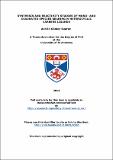Files in this item
Synthesis and reactivity studies of mono- and diaurated species bearing N-heterocyclic carbene ligands
Item metadata
| dc.contributor.advisor | Nolan, Steven P. | |
| dc.contributor.author | Gómez Suárez, Adrián | |
| dc.coverage.spatial | 166 | en_US |
| dc.date.accessioned | 2015-04-23T12:51:56Z | |
| dc.date.available | 2015-04-23T12:51:56Z | |
| dc.date.issued | 2014-12-01 | |
| dc.identifier | uk.bl.ethos.644825 | |
| dc.identifier.uri | https://hdl.handle.net/10023/6546 | |
| dc.description.abstract | The use of Au-NHC complexes in homogenous gold catalysis has become very popular during the last 10 years. The work described in this thesis represents a modest contribution towards a better understanding of the reactivity of these fascinating complexes and the intermediate species involved during gold-catalysed transformations. There are two main themes that permeate the following chapters: a) synthesis and reactivity studies of monoaurated species and b) synthesis and reactivity studies of diaurated species. The main motivation for the work presented herein was to develop more efficient synthetic routes towards a series of gold complexes, such as [Au(NHC)Cl], [Au(NHC)(OH)] and [{Au(IPr)}₂(μ-OH)][X], in order to be able to further explore their reactivity. Chapter 2 constitutes the first approach that I had with the chemistry of Au-NHC complexes, and describes our efforts to evaluate how the use of a highly sterically demanding NHC ligand affects gold-catalysed transformations. Chapters 3 and 4 explore alternative, more efficient synthetic routes towards known Au- NHC complexes. For example, a new, highly robust protocol has been developed for the synthesis of [Au(NHC)X] (X = Cl, Br, I) complexes, which are the starting materials to prepare a wide range of Au-NHC based species. Moreover, as a result of our investigations it has been possible to isolate a series of [Au(NHC)(OH)] species and to gain some insight into the stability of these complexes. Chapters 5 and 6 describe the synthesis and applications of digold hydroxide species [{Au(IPr)}₂(μ-OH)][X] in a series of catalytic and stoichiometric transformations. For example, they have been used as silver-free catalysts for water-inclusive gold-catalysed transformations or to access key intermediates in gold catalysis, such as gem-diaurated and σ,π-digold-acetylide species. Finally, Chapter 7 combines what we learned about the reactivity of [{Au(IPr)}₂(μ- OH)][X] in order to develop for the first time a gold-catalysed transformation where two gold centres independently react with two substrate molecules to catalyse the hydrophenoxylation of alkynes. | en_US |
| dc.language.iso | en | en_US |
| dc.publisher | University of St Andrews | |
| dc.subject | Gold | en_US |
| dc.subject | Homogeneous catalysis | en_US |
| dc.subject | NHC | en_US |
| dc.subject | Metal hydroxides | en_US |
| dc.subject | Dual activation | en_US |
| dc.subject.lcc | QD412.A9G7 | |
| dc.subject.lcsh | Organogold compounds--Synthesis | en_US |
| dc.subject.lcsh | Organogold compounds--Analysis | en_US |
| dc.subject.lcsh | Homogeneous catalysis | en_US |
| dc.subject.lcsh | Heterocyclic compounds | en_US |
| dc.subject.lcsh | Carbenes (Methylene compounds) | en_US |
| dc.subject.lcsh | Ligands | en_US |
| dc.title | Synthesis and reactivity studies of mono- and diaurated species bearing N-heterocyclic carbene ligands | en_US |
| dc.type | Thesis | en_US |
| dc.type.qualificationlevel | Doctoral | en_US |
| dc.type.qualificationname | PhD Doctor of Philosophy | en_US |
| dc.publisher.institution | The University of St Andrews | en_US |
This item appears in the following Collection(s)
Items in the St Andrews Research Repository are protected by copyright, with all rights reserved, unless otherwise indicated.

